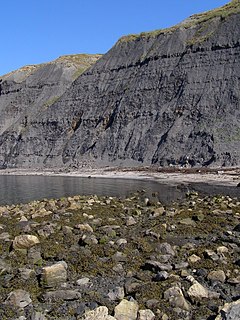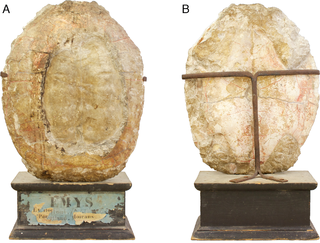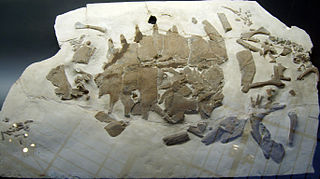
The Kimmeridge Clay is a sedimentary deposit of fossiliferous marine clay which is of Late Jurassic to lowermost Cretaceous age and occurs in southern and eastern England and in the North Sea. This rock formation is the major source rock for North Sea oil. The fossil fauna of the Kimmeridge Clay includes turtles, crocodiles, sauropods, plesiosaurs, pliosaurs and ichthyosaurs, as well as a number of invertebrate species.

Thalassemys is a genus of extinct thalassochelydian turtle from the Late Jurassic of western and central Europe. While the genus was originally named by Rütimeyer in 1859 for a large carapace and other associated fragments from the late Kimmeridgian of the Reuchenette Formation of Switzerland, although the taxon was not validly named until 1873 when Rütimeyer designated the type species T. hugii. Rütimeyer also named T. gresslyi from the Reunchenette Formation in the same paper as T. hugii, but it cannot be differentiated from the type material of T. hugii and is therefore a junior synonym. A large assemblage of shell and postcranial material from the Reunchenette was named as a species of Eurysternum, E. ignoratum, by Bräm in 1965. While originally distinguished based on the presence of fontanelles on the plastron, the feature was later identified on T. hugii and E. ignoratum was designated a junior synonym. Additional material from the Kimmeridge Clay of the United Kingdom has also been referred to T. hugii.
Hispaniachelys is an extinct genus of thalassochelydian turtle known from the Lorente Formation of southern Spain. Reinterpretation of the original material shows that the taxon lacks diagnostic characteristics and is thus a nomen dubium.

Palaeomedusa testa is an extinct species of thalassochelydian turtle from the Tithonian of the Late Jurassic. It was first described by the German palaeontologist Christian Erich Hermann von Meyer in 1860. It is the only species classified under the genus Palaeomedusa.

Plesiochelys is a genus of late Jurassic European and Asian turtle. The type species is Plesiochelys etalloni.

The Plesiochelyidae are an extinct family of turtles in the clade Thalassochelydia originally classified within the Cryptodira suborder, mostly belonging from the Jurassic period. An alternate study placed the clade Thalassochelydia in the Angolachelonia and outside the Testudines.

Eurysternidae is an extinct family of turtles in the clade Thalassochelydia. It consists of several genera of marine turtles from marine deposits in Europe, including Achelonia, Chelonides, Eurysternum. Hydropelta, Chelonides, Idiochelys, Palaeomedusa, Parachelys. and Solnhofia.
Achelonia is an extinct genus of marine thalassochelydian turtle. Its type species is Achelonia formosa. Fossils are known from the Upper Jurassic of Wattendorf, Germany, Cerin, France, and England. Material from England was originally considered to belong to the separate genus Enaliochelys and species Enaliochelys chelonia, named by Harry Govier Seeley in 1869 for a partial disarticulated skeleton from the early Kimmeridgian of the Kimmeridge Clay in Cambridgeshire. The synonymy was recognised in 2020.
Cyrtura is a dubious genus of extinct Testudinata from the Late Jurassic of the Solnhofen Formation of Bavaria, Germany. Cyrtura was originally described as a temnospondyl amphibian by Otto Jaekel in 1904 on the basis of MNB 1890, the distal portion of a tail with 14 caudal vertebrae. Most authors overlooked the genus, although those who mentioned Cyrtura dismissed it as either undiagnostic or referable to Testudines rather than Temnospondyli. Warren and Hutchinson (1983) rejected the temnospodyl classification of the genus based on examination of a cast of the holotype, and subsequent studies showed that Cyrtura is actually a marine turtle, although the lack of diagnostic characters renders it a nomen dubium.
Neusticemys is an extinct genus of thalassochelydian sea turtle. Its type species is Eurysternum neuquinum. It is known from the Late Jurassic (Tithonian) aged Vaca Muerta of Patagonia, Argentina
Parachelys is a genus of Late Jurassic turtle from marine deposits in Bavaria, southern Germany.
Hydropelta is a genus of Late Jurassic turtle from marine deposits in the Jura Mountains of eastern France.
Chelonides is a genus of late Jurassic turtle from marine deposits in Lower Saxony, Germany.

Idiochelys is a genus of Late Jurassic turtle from marine deposits in the Jura Mountains of eastern France and Bavaria, Germany.

Thalassochelydia is a clade of extinct marine turtles from the Late Jurassic and earliest Cretaceous of Europe and South America. The group is defined as including Eurysternum, Plesiochelys and Thalassemys to the exclusion of Pelomedusa, Testudo and Protostega. While a clade uniting the families Eurysternidae, Plesiochelyidae and Thalassemydidae had been supported by phylogenetic evidence, a name was not given for the clade until 2017, when Jérémy Anquetin and colleagues coined Thalassochelydia.

Solnhofia is a genus of extinct thalassochelydian turtle from the Late Jurassic of Germany. The type species is Solnhofia parsonsi, named by Gaffney in 1975 for a partial skull and jaw from the early Tithonian of the Solnhofen Formation in Bavaria. Additional material including a complete skeleton is known from the late Kimmeridgian of Switzerland and the Kimmeridgian/Tithonian of other deposits within Bavaria, and potentially also unprepared material from the Late Jurassic of France. The genus was referred to the family Eurysternidae by Anquetin and colleagues in 2017, which may represent an artificial grade of early thalassochelydians. In 2020 a new species Solnhofia brachyrhyncha was described from the Kimmeridigan aged Reuchenette Formation of Switzerland.
Aplax is a dubious genus of extinct thalassochelydian turtle from the Late Jurassic of Germany. The type and only species is Aplax oberndorferi, named by Hermann von Meyer in 1843 for a complete juvenile skeleton from the early Tithonian of the Solnhofen Formation in Bavaria. Despite being aware that shell morphology changes during growth, Meyer named Aplax due to his consideration it represented a relative of Dermochelys, where the adults lack distinction of shell regions as in Aplax. However the taxon was later referred to Thalassochelydia by Anquetin and colleagues in 2017, and due to the loss of the original holotype it cannot be identified as a distinct taxon of a juvenile of existing Solnhofen turtles and is therefore a nomen dubium.
Euryaspis is a dubious genus of extinct thalassochelydian turtle from the Late Jurassic of Germany. The type and only species is Euryaspis radians, originally proposed by Wagner in 1859 before being validly described and illustrated in 1861. The only specimen was a partial carapace probably from the Tithonian, although the original locality is unknown. The genus is referred to Thalassochelydia and has been considered a synonym of Eurysternum or Acichelys before, but casts that remain of the lost holotype show that it bears no features that can clarify its validity making it a nomen dubium.
Owadowia is a genus of extinct thalassochelydian turtle from the Late Jurassic of Poland. The type and only species is Owadowia borsukbialynickae, named by Szczygielski and colleagues in 2017 for a partial lower jaw, coracoid, ilium and femur from the early Tithonian Kcynia Formation. The limited material means that it is difficult to compare Owadowia to its relatives, and it may not be a unique taxon. The genus lacks the features diagnostic to its parent clade Thalassochelydia, has similarities to Solnhofia and Portlandemys as well as being a Late Jurassic marine turtle like the remainder of the group.
Pelobatochelys is a genus of extinct thalassochelydian turtle from the Late Jurassic of the United Kingdom. The type and only species is Pelobatochelys blakii, named by Harry Govier Seeley in 1875 for a central carapace fragment along with five additional specimens from the remainder of the shell from the early Kimmeridgian of the Kimmeridge Clay in Dorset, and additional material from the Kimmeridge Clay has also been referred to the taxon. The material was considered to be related to various turtles throughout time, including being reassigned to Tropidemys as T. blakii based on limited evidence. A large shell also from Weymouth, Dorset may represent further material of Pelobatochelys, but could also be from Tropidemys langii which was also present in the deposits.










